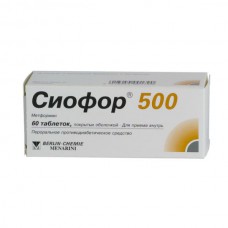Expiration date: 03/2025
Release form and composition:
Siofor® 500
The tablets covered with a cover of white color, round, biconcave.
1 tablet contains of 500 mg of metformin hydrochloride
Other ingredients: hypromellose, povidone, magnesium stearate, macrogol 6000, titanium dioxide (E171).
Siofor® 850
Film-coated tablets White, oblong, with two-way mark.
1 tablet contains of 850 mg of metformin hydrochloride
Other ingredients: hypromellose, povidone, magnesium stearate, macrogol 6000, titanium dioxide (E171).
Siofor® 1000
Film-coated tablets White, oblong, with bilateral notch for division.
1 tablet contains 1000 mg of metformin hydrochloride
Excipients: povidone K25, hypromellose, magnesium stearate, macrogol 6000, titanium dioxide (E171).
Pharmachologic effect:
Hypoglycemic drug from the biguanide group. It lowers both basal and postprandial blood glucose levels. It does not stimulate insulin secretion and therefore does not cause hypoglycemia. The action of metformin, probably based on the following mechanisms:
- Decrease glucose production in the liver due to inhibition of gluconeogenesis and glycogenolysis
- Improving the sensitivity of muscles to insulin and consequently improve glucose uptake in the periphery and its utilization
- Inhibition of glucose absorption in the intestines.
Metformin through their action on glikiencintetazu stimulates intracellular glycogen synthesis. It increases the transport capacity of all hitherto known glucose membrane transport proteins.
Regardless of the effect on the blood glucose level has a beneficial effect on lipid metabolism, leads to a decrease in total cholesterol, LDL cholesterol and triglycerides.
Pharmacokinetics:
Suction
After oral Cmax is reached after about 2.5 hours in the blood plasma. When absorption decreases food intake and slows down slightly. Metformin plasma Cmax at the maximum dosage does not exceed 4 micrograms / ml. Absolute bioavailability in healthy subjects is approximately 50-60%.
Distribution
Almost does not bind to plasma proteins. The average Vd is 63-276 liters.
Breeding
Return with urine in unchanged form. Renal clearance was 400 ml / min. After ingestion T1 / 2 is about 6.5 hours.
Pharmacokinetics in special clinical situations
By reducing the clearance of renal function decreases in proportion to creatinine clearance. Thus, T1 / 2 longer and increases the concentration of metformin in the plasma.
Testimony:
- Type 2 diabetes mellitus (insulin dependent), especially in combination with obesity with poor diet.
Possible to assign a single agent and in combination with other oral hypoglycemic agents or insulin.
Dosage and administration:
Dose set individually depending on the level of blood glucose. Therapy should be conducted with gradually increasing doses ranging from 0.5-1 g (Table 1-2). Siofor® drug 500 or 850 mg (1 tab.) Of the drug Siofor® 850. Then, depending on the level of glucose in the blood dose increased at an interval of 1 week to an average daily dose of 1.5 g (3 tablets.) preparation Siofor® 500 or 1.7 g (2 tab.) preparation Siofor® 850. The maximum daily dose Siofor® 500 - 3 g (6 tab.) drug Siofor® 850 - 2.55 g (3 tablets.).
The average daily dose is 2 Siofor® 1000 g (2 tab.). The maximum daily dose of the drug Siofor® 1000 - 3 g (3 tablets.).
The drug should be taken during meals, without chewing, drinking plenty of fluids.
If the daily dose of more than 1 tab., It should be divided into 2-3 doses. The duration of Siofor® preparation determined by the physician.
Missed the drug should not be compensated for by a single dose, respectively, more pills.
Due to the increased risk of lactic acidosis, the dose should be reduced in severe metabolic disorders.
Side effects:
From the digestive system: at the beginning of treatment - nausea, vomiting, a metallic taste in the mouth, loss of appetite, diarrhea, flatulence, abdominal pain. Reduce the frequency and intensity of side effects data could gradually increase the drug dose and during or after a meal. Discontinuation of treatment course is not required, since in most cases complaints disappear even at an unchanged dose of the drug.
From a metabolism: in a few cases (with an overdose of the drug in the presence of diseases in which the use of the drug is contraindicated in alcoholism) lactic acidosis (requires discontinuation of treatment) can develop. Long-term treatment may develop hypovitaminosis B12 (malabsorption).
From the hematopoietic system: in some cases - megaloblastic anemia.
From the Endocrine: hypoglycemia (in violation of the dosing regimen).
Allergic reactions: seldom - skin rash.
Contraindications:
- Diabetes mellitus type 1
- A complete cessation of its own secretion of insulin in the body in diabetes mellitus type 2
- Diabetic ketoacidosis, diabetic precoma, coma
- Violation of the liver and / or kidney disease
- Myocardial infarction
- Heart failure
- dehydration
- Severe lung disease with respiratory failure
- Severe infections
- Surgery, trauma
- Catabolic state (a state with strengthening the process of decay, such as tumor diseases)
- Hypoxic conditions
- Alcoholism
- Lactic acidosis (including history)
- pregnancy
- Lactation (breastfeeding)
- Compliance with the diet with restriction of caloric intake (less than 1000 kcal / day)
- childhood
- Application for 48 hours or less before and within 48 hours after the radioisotope or radiological examinations with iodinated contrast agent administration (Siofor®1000)
- Hypersensitivity to the drug.
Precautions should use the drug in patients older than 60 years, performing heavy physical work, which is associated with increased risk of developing lactic acidosis.
Pregnancy and lactation:
The drug is contraindicated during pregnancy and lactation (breastfeeding).
Special instructions:
Before the appointment of the drug, and every 6 months is necessary to monitor liver and kidney function.
It is necessary to control the level of lactate in the blood of at least 2 times a year.
The course of treatment with Siofor® Siofor® 500 and 850 should be replaced by other treatment hypoglycemic agents (eg, insulin) for 2 days before the X-ray examination with a / in the introduction of iodine-containing contrast media, as well as 2 days before surgery under general anesthesia, and to continue this therapy for a further 2 days after the survey or after surgery.
In combination therapy with sulfonylureas, careful monitoring of blood glucose.
Effects on ability to drive vehicles and management mechanisms
In applying the drug Siofor® not recommended to engage in activities requiring concentration of attention and fast psychomotor reactions due to the risk of hypoglycemia.
Overdose:
Symptoms: acidosis, symptoms are severe weakness, respiratory disorders, drowsiness, nausea, vomiting, diarrhea, abdominal pain, hypothermia, reduced blood pressure, reflex bradyarrhythmia. May include the muscle pain, rapid breathing, confusion and loss of consciousness.
Treatment: symptomatic therapy.
Drug Interactions:
While the use of sulfonylureas, acarbose, insulin, NSAIDs, inhibitors of MAO, oxytetracycline, ACE inhibitors, clofibrate derivatives, cyclophosphamide, beta-blockers may increase the hypoglycemic effect of the drug Siofor®.
While the use of corticosteroids, oral contraceptives, epinephrine, sympathomimetics, glucagon, thyroid hormones, phenothiazine derivatives, derivatives of nicotinic acid may reduce the hypoglycemic action Siofor® drug.
Siofor® can weaken the effect of indirect anticoagulants.
While the use of ethanol increases the risk of lactic acidosis.
Pharmacokinetic interactions
Furosemide increased the metformin Cmax plasma.
Nifedipine increases absorption, Cmax plasma metformin prolongs its excretion.
Cationic drugs (amiloride, digoxin, morphine, procainamide, quinidine, quinine, ranitidine, triamterene, vancomycin) secreted in the tubules, compete for tubular transport system and long-term therapy may increase Cmax plasma metformin.
Cimetidine slows the elimination of metformin, thus increasing the risk of lactic acidosis.
Metformin reduces plasma Cmax and T1 / 2 of furosemide.
Conditions and terms:
The drug should be stored out of reach of children, protected from light at a temperature not exceeding 25 ° C. Shelf life - 3 years.




